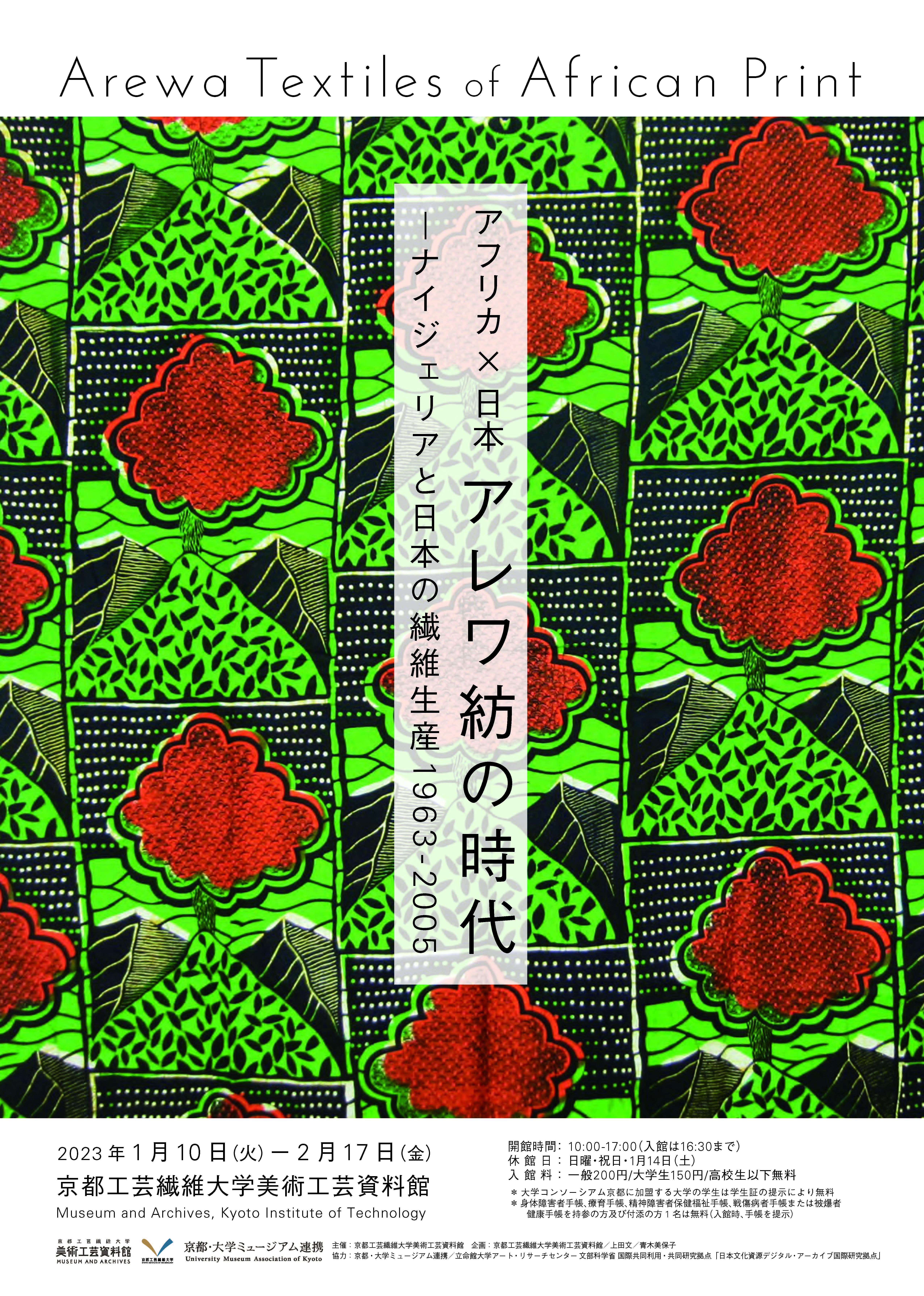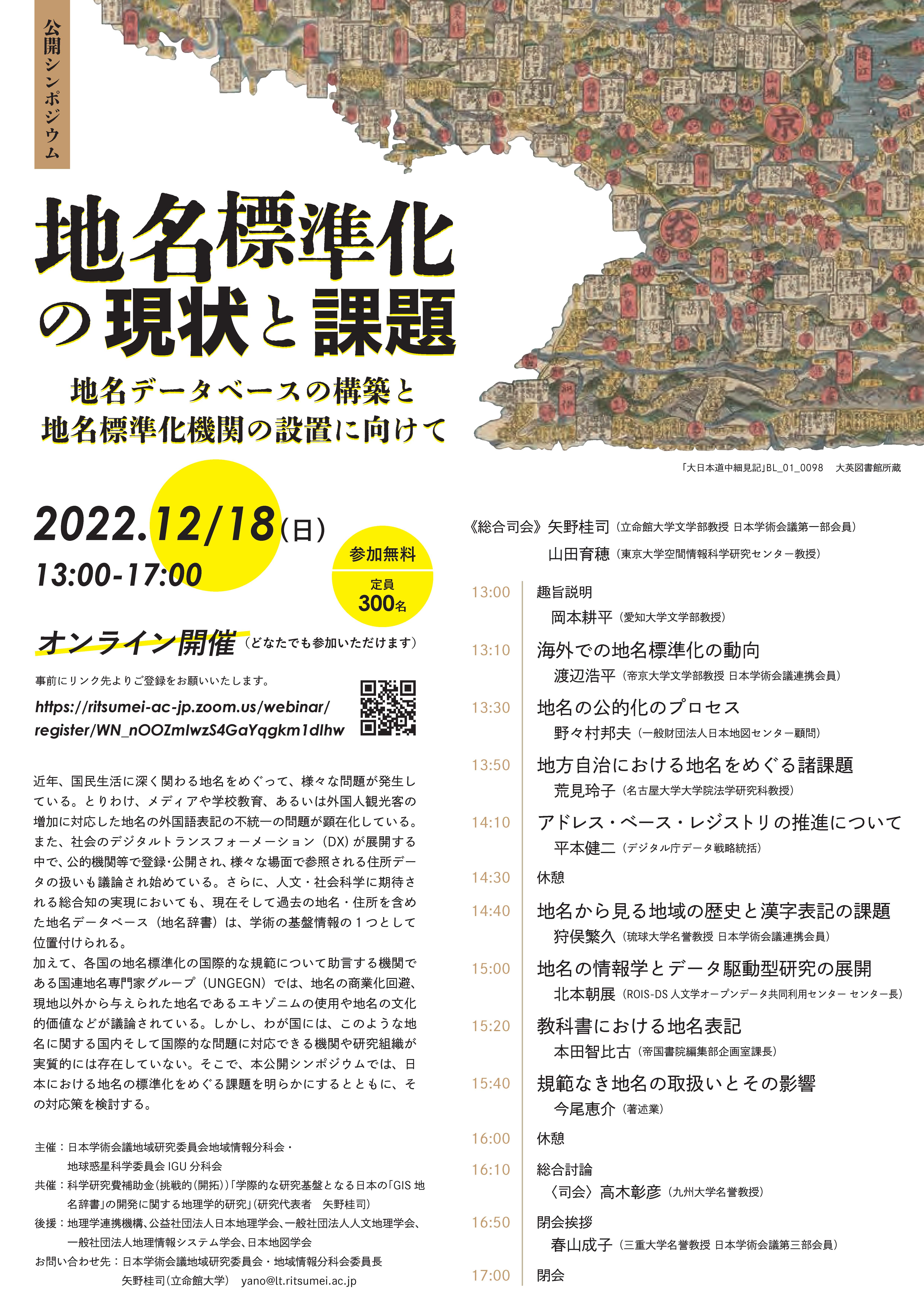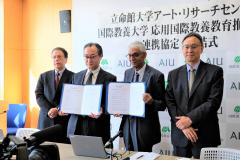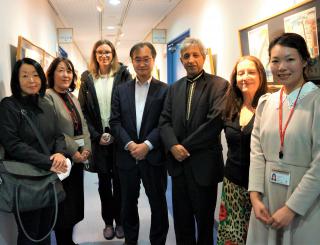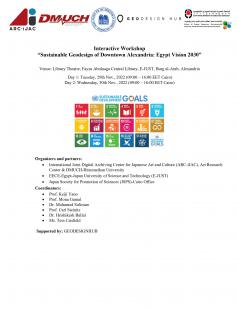-
 11
12
13
14
15
16
17
18
19
20
21
11
12
13
14
15
16
17
18
19
20
21

立命館大学アート・リサーチセンター 部科学省 国際共同利用・共同研究拠点「日本文化資源デジタル・アーカイブ国際研究拠点」(ARC-iJAC)協力のもと、「アフリカ× 日本 アレワ紡の時代 ―ナイジェリアと日本の繊維生産 1963-2005」が開催されます。
開催期間:2023年1月10日(火)-2月17日(金)
主催:京都工芸繊維大学美術工芸資料館
共催:国際共同研究採択課題「新しい近代京都機械捺染史構築に向けて―近代デザインと産業史をむすぶデジタル・アーカイブを一助として―」(プロジェクトリーダー:関西学院大学非常勤講師、同志社女子大学非常勤講師 上田 文)
協力:京都・大学ミュージアム連携/立命館大学アート・リサーチセンター 部科学省 国際共同利用・共同研究拠点「日本文化資源デジタル・アーカイブ国際研究拠点」
詳細はこちら ↓ ↓ ↓
2023年2月18日(土)に第12回「知識・芸術・文化情報学研究会」を開催いたします。それに伴い、発表者の募集をいたします。奮ってご応募ください。
実施方法: 対面およびオンライン(Zoom)によるハイブリッド方式
会場:立命館大学 大阪いばらきキャンパス
〒567-8570 大阪府茨木市岩倉町2-150
※新型コロナウイルス感染症の感染拡大状況により、全面オンライン開催となる可能性もあります。応募方法: 2022年12月28日(水)までに、発表申込みフォーム https://forms.gle/9LMBxercKFYkWw4v6 より申し込むこと。 発表時間: 質疑込み20分程度。ただし発表者数により調整する。(発表時間および発表資料提出の要領は締め切り後、発表者に連絡します。) 参 加 費: 無料 研究分野: 1. 情報技術を使った芸術・文化分野やその他の分野の研究
2. 芸術・文化やその他の分野に応用できる情報技術の研究研究発表の内容例: 1. 芸術分野やその他の分野の情報・知識の構造解析、モデル化、可視化、知識発見
2. 芸術分野やその他の分野の情報・知識の表現、生産、組織化・DB構築、検索、提供
3. 電子出版、電子図書館、電子博物館・美術館
4. 芸術分野やその他の分野の用語、シソーラス
5. 芸術分野やその他の分野の情報・知識の流通と知的所有権
6. オープンデータ、データパブリッシング、リンクトデータ
7. インターネット、セマンティックウエブ、Web x.0 など
8. その他、広く文化を対象とした情報・知識に関連する諸研究・開発主 催: 知識・芸術・文化情報学研究会
世話役〔五十音順〕:赤間 亮(立命館大学)、阪田真己子(同志社大学)、田窪直規(近畿大学)、村川猛彦(和歌山大学)共 催: アート・ドキュメンテーション学会関西地区部会、情報知識学会関西部会 協 力: 立命館大学アート・リサーチセンター 文部科学省 国際共同利用・共同研究拠点「日本文化資源デジタル・アーカイブ国際共同研究拠点」 問い合わせ: kacimeeting+2023■gmail.com (■を@に変えて下さい) 「知識・芸術・文化情報学研究会」詳細: 昨今のデジタル・情報環境の急速な進展とともに、学術分野にも「情報」や「デジタル」を意識した分野横断型の研究が多く見受けられるようになってきました。大学の教育・研究活動においても、この傾向は強まっており、これに関連する教育プログラムやコースの活動が充実しています。
時代に即した新しい研究テーマのもと、このような課程で学ぶ学部生・大学院生や若手研究者が学術的な交流をする機会へのニーズはますます大きくなっています。
そのため、芸術・文化、およびその他の関連する分野の情報・知識研究に興味のある大学院生および若手研究者を主に意識し、発表・交流のための場として「知識・芸術・文化情報学研究会」を2011年度に発足させ、これまで11回の研究集会を開催しました。
本会は、異分野の人的交流を通じて、参加者相互が新たな研究テーマや方法を発見できる場と位置づけており、学会発表とはひと味違う萌芽的・冒険的な発表も歓迎します。[イベント情報]2022年12月26日(月)ARC-iJACでは、2023年度に本拠点から研究に必要な経費の配分を受けて共同研究を行う、国際共同研究課題〔研究費配分型〕を公募しています。申請締切は2023年1月20日(金)午後17時です。
国際共同研究課題〔研究費配分型〕の公募要項・申請書はこちら
続きを読む>>2022年12月21日(水)18:00より、Web配信にて第113回国際ARCセミナーを開催いたします。
プログラムは下記となります。
1.
講師:荻田みどり先生 (舞鶴工業高等専門学校 人文科学部門 講師)タイトル:「工業高等専門学校における古典と科学の融合を考える授業実践――くずし字翻刻学習・支援システムを用いて」
2.
講師:張宇涛氏 (立命館大学大学院 情報理工学研究科音情報処理研究室 博士課程後期課程)タイトル:「くずし字翻刻のための古文用音声認識システムの検討」
日時:2022年12月21日(水)18:00~19:30
参加:Zoom配信(関係者のみ・予約不要)
※ARCメンバー以外の方は Youtubeよりご参加いただけます。こちらからご覧下さい。
立命館大学アート・リサーチセンターの矢野桂司教授(文学部)が総合司会を務める公開シンポジウム「地名標準化の現状と課題:地名データベースの構築と地名標準化機関の設置に向けて」が開催されます。
開催日時:2022年12月18日(日)13:00-17:00
開催方法:オンライン
対象 :どなたでもご参加いただけます(要申込)詳細 >>「地名標準化の現状と課題:地名データベースの構築と地名標準化機関の設置に向けて」
申込 >>申込フォーム
2022年11月28日、立命館大学アート・リサーチセンター(ARC)は、公立大学法人国際教養大学(AIU)応用国際教養教育推進機構と、学術研究交流に関する連携協定を締結いたしました。
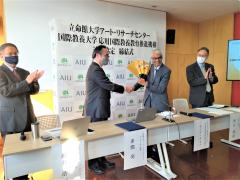 国際教養大学で行われた協定締結式には、国際教養大学からは、モンテ・カセム学長、熊谷嘉隆副学長が出席され、アート・リサーチセンターからは、赤間亮センター長(文学部)、細井浩一副センター長(映像学部)が出席しました。カセム学長は、立命館アジア太平洋大学(APU)の学長および学校法人立命館副総長を歴任された方で、今回の連携協定を実現するために中心的な役割を果たしてくださいました。
国際教養大学で行われた協定締結式には、国際教養大学からは、モンテ・カセム学長、熊谷嘉隆副学長が出席され、アート・リサーチセンターからは、赤間亮センター長(文学部)、細井浩一副センター長(映像学部)が出席しました。カセム学長は、立命館アジア太平洋大学(APU)の学長および学校法人立命館副総長を歴任された方で、今回の連携協定を実現するために中心的な役割を果たしてくださいました。この連携協定締結により、秋田県内の300以上の民俗芸能を収録・公開しているAIUの「秋田民俗芸能アーカイブス」が、日本文化・芸術のデジタル・アーカイブでは最大規模の研究活動を行っているアート・リサーチセンターのARCポータルデータベースシステムと連携することになります。
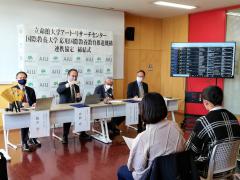 これにより、「秋田民俗芸能アーカイブス」のアクセス数の増加が見込まれ、その結果、民俗芸能の映像資料等の活用が世界的に促進されるだけでなく、秋田の民俗芸能の継承に寄与することも期待できます。
これにより、「秋田民俗芸能アーカイブス」のアクセス数の増加が見込まれ、その結果、民俗芸能の映像資料等の活用が世界的に促進されるだけでなく、秋田の民俗芸能の継承に寄与することも期待できます。今後は、共同研究プログラムの組織・参加、両機関の研究者の交流を模索し、双方の学術研究を強化していく予定です。
締結式に続いて行われた座談会では、熊谷教授が「秋田民俗芸能アーカイブス」を紹介され、赤間教授が、同アーカイブスとARCポータルデータベースシステムとの連携について説明されました。その後、双方の参加者4名全員よりARCとAIUの文化継承に対する思いについて、座談会形式で話し合われました。
国際教養大学(AIU)公式サイト:https://www.aiu.ac.jp
秋田民俗芸能アーカイブス: https://www.akita-minzoku-geino.jp/archives/ja/
立命館大学アート・リサーチセンター(ARC)データベース:https://www.arc.ritsumei.ac.jp/j/database/
[イベント情報]2022年12月 8日(木)On November 21 (Mon), 2022, Professor Adam Habib, the Director of the School of Oriental and African Studies (SOAS), University of London, visited Ritsumeikan University to meet with Professor Yoshio Nakatani, President of Ritsumeikan University. SOAS is a world-leading institution for the study of Asia, Africa, and the Middle East.
Accompanied by Professor Nana Sato-Rossberg, Chair of the SOAS Centre of Translation Studies and an alumna of Ritsumeikan University's Graduate School of Core Ethics and Frontier Sciences, and Kanina Foss, Chief of Staff, Professor Habib visited the Art Research Center (ARC) as part of this trip where he met with Professor Ryo Akama, Director of the ARC.
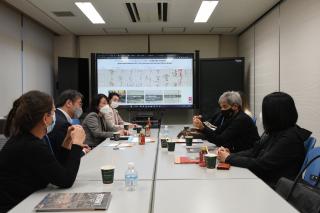
After Professor Akama introduced the international joint research projects of the ARC in digital humanities, including digital archiving projects in collaboration with the British Museum (BM) and faculty members of SOAS, the two of them discussed the possibility of establishing a partnership in digital humanities with a focus on digital archiving the Japanese collection held by SOAS.
Furthermore, Professor Habib was keen on exploring opportunities for future collaboration in video game research, in particular, gaming with a social justice element.
During the meeting at the ARC, Professor Habib praised the center's efforts in digital humanities research and in serving as an international hub for joint research in the digital archiving of Japanese art and culture as he expressed the aspiration of SOAS to serve as a bridge for different, transnational knowledge systems.
2022年12月7日(水)18:00より、Web配信にて第111回国際ARCセミナーを開催いたします。
プログラムは下記となります。
1.
講師:Fadjar I. Thufail, Ph.D. (Director, Research Center for Area Studies (PRW) National Research and Innovation Agency (BRIN))
Upik Sarjiati, MPP (Researcher, Research Center for Area Studies (PRW) National Research and Innovation Agency (BRIN))タイトル:「“Assembling Borobudur as a World Heritage: An Actor-Network Approach”」
2.
講師:Bramantara, ST. MA. (Borobudur Conservation Office)タイトル:「“Reshaping the Past: The Use of 3D Technology for the Preservation of Cultural Heritage in Indonesia”」
日時:2022年12月7日(水)18:00~19:30
参加:Zoom配信(関係者のみ・予約不要)
[イベント情報]2022年11月29日(火)インタラクティブなワークショップ「Sustainable Geodesign of Downtown Alexandria: Egypt Vision 2030」が アート・リサーチセンター 国際共同利用・共同研究拠点「日本文化資源デジタル・アーカイブ国際共同研究拠点」(ARC-iJAC)共催のもと開催されます。
開催場所:Library Theatre, Fayza Abulnaga Central Library, E-JUST, Burg al-Arab, Alexandria
1日目 : 2022年11月29日(火)(9:00 - 16:00 EET Cairo / 16:00 - 23:00 JST)
2日目 : 2022年11月30日(水)(9:00 - 16:00 EET Cairo / 16:00 - 23:00 JST)参加希望の方は、r-darc@st.ritsumei.ac.jp までご連絡ください。
ワークショップ詳細はこちら↓↓↓

好評をいただいております「チューター添削指導のあるくずし字解読力錬成講座」を再開します。
この講座は、ARC古典籍・浮世絵・古文献データベース、ならびに「くずし字翻刻支援・教育システム」を使ってオンライン上で行われるもので、いつでも、どこでも、自由に時間を使って訓練ができます。特徴は、AIによるサジェスト機能が使えること、熟練のチューターによって添削指導を受けられることです。単発で行われるくずし字講座とは違い、自身で作品・資料を読み進めながら解読能力の訓練をしていくことができます。
初級・中級レベルの方々は勿論、特定の作品・作品群の翻刻プロジェクトへの支援を希望する場合も参加できます。
参加費は無料です。
なお、本講座は、令和 4(2022)年度「国際日本研究」コンソーシアム公募事業の支援を受けています。参加希望の方は下記のフォームからお申し込みください。
申込みフォーム募集は終了しました。
締切日:2022年11月22日(火)12時(JST)【実施内容詳細】
実施期間:2022年12月4日から2023年3月15日まで
使用言語:日本語対象:
1、くずし字で書かれた文献を解読していきたい初心者から中級者(定員:25名)
2、くずし字翻刻システムを使い、自身のプロジェクトを推進したい個人・グループ
(個別添削はありませんが、難読文字等の相談ができます。定員:5名・グループ)スケジュール
11月25日頃 採択通知 11月30日(JST 20時) キックオフセミナー開催(オンライン・見逃し配信があります)
・基調講演 明星大学准教授勝又基氏、
その他講座の概要・システムの説明、チューターの紹介など12月4日 第1回システム講習会(オンライン)
Aセッション(JST:9時開始)、Bセッション(JST:20時開始)
※期間中数回のシステム講習会を予定しています。3月下旬 クロージング・ミーティング開催 【問合せ先】
立命館大学アート・リサーチセンター
国際卿共同利用共同研究拠点 事務局
Email: r-darc@st.ritsumei.ac.jp
Tel: +81-75-465-8476 11
12
13
14
15
16
17
18
19
20
21
11
12
13
14
15
16
17
18
19
20
21



